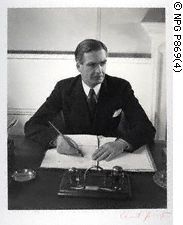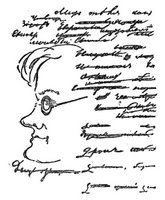'TRANSFORMING A LOUIS XIV WINE BOTTLE INTO A COKE BOTTLE': THE NEW 'FOREIGN AFFAIRS' SEVENTEEN YEARS ON
In my youth as an under-graduate at University, I first started to read and indeed subscribed to the American periodical Foreign Affairs. It was then edited by that august, paragon of the WASP ascendancy, William P. Bundy, the son-in-law of Dean Acheson and the older brother of the equally august and mandarin McGeorge Bundy. In short, at that time, and for a good while longer, the periodical was a sort of 'house journal' of the old-school elements of the American foreign policy establishment. Which is not to say that it had an overt 'line' in any particular policy questions or debates. Indeed, one of the many virtues of the 'old' Foreign Affairs (hereafter 'FA', for short), was that it deliberately positioned itself as being open to all points of view, and one was as likely to read an analysis of say American foreign policy by a Soviet academic, as one was to read an analysis of Sovietskaya Vlast by an American academic. Particularly useful and a quite frequent event in the periodical at that time was the position piece by a foreign minister, head of state or some such equivalent figure, outlining or defending the policies of his government or country to the FA audience. However the chief virtue perhaps of the old FA, a virtue which it shared with the old New Yorker (the New Yorker of William Shawn that is), was that in the words of the late great Dwight Macdonald:
'it was edited for the people who wrote for it, and, only incidentally for the people who bought and read it'.
Meaning that in reading and purchasing the periodical, one was entering a mental universe which was not geared towards satisfying the whims of the general public, or even the lay educated, general public. With the end result being that while not by any means perfect, the old FA, was about as good a foreign policy periodical that one could wish to read in those days. There were longish (in the best old New Yorker style) articles on subjects which while perhaps topical at one time were no longer on the top of any one's popularity chart. Indeed, there were a whole slew of articles, by such grandiose figures as Robert Tucker, Isaiah Berlin, Sir Michael Howard, Raymond Aron, Paul Nitze, David Calleo, George Kennan, William McNeill, among others. Articles which could have very well be published in academic journals, and, which had all the appearances of the same: long historical backgrounds, and explanations, as well as that quintessential aspect of the academic article: a footnote.
I stopped reading FA sometime in 1990, as it interfered with my doctoral studies, and, perhaps because of a certain snobbish aspect of reading something which even had the slightest inkling of being aimed at an non-academic audience. Which in retrospect was a pity, since within two years time, a veritable revolution came upon the old FA, and, transformed it into the version that one sees today. This revolution like all such events was perhaps not necessarily well-thought out. And, again like all revolutions it was inspired by a mixture of motives: apparently, in the case of the Council on Foreign Relations, it was a feeling (this is a bit of guesswork on my part) that FA, while wonderful for what it was doing, was a bit 'old hat', and, needed to be (to use a vernacular expression of American origins) 'jazzed up'. I would imagine that perhaps the chief inspiration for this feeling was that the pernicious event, the publication in the summer of 1989, in the then new, periodical The National Interest, of Francis Fukuyama's rather facile and convoluted exercise in trying to make Hegelian metaphysics understandable for the great unwashed masses of the pays legal of official Washington: 'The End of History and the Last Man'. Which however much it reads laughably today (or for some of us, even then), was regarded by many in the world of foreign policy thinkers, as the very dernier cri of such exercises. The historical successor to George Frost Kennan's 'Sources of Soviet Conduct', essay of 1947.
With that as a background, it perhaps makes more understandable (if not necessarily very comprehensible even at this point in time), the hiring as the next Editor (only the fourth since 1922) of Mr. James Hoge. A provincial (from Chicago), second-rate hack journalist, and, his deputy, Fareed Zakaria, a no account mountebank from Dieu knows where. And, the revolution was on: end notes were dropped, the periodical's gray color was jettisoned for a light bluish color, with the titles to the various articles highlighted in boldface, the size of the same were cut by almost one-third (from an average of 7000 words to under 5000), with many now being of a much more topical and journalistic in nature. And, the creme de la creme of the new FA, the crowning glory of the enterprise: cartoons were added. For what purpose one dares not say or hazard a surmise. In short, what was once an erste-klasse periodical, was turned in a much more demotic and vulgar (using that word in its etymological original sense of 'base'& 'common')one. Or as the egregious Zakaria put it to the New York Times, more than ten years ago: "the aim now is to edit the magazine for the reader, rather than the writer" (see: "Foreign Affairs Magazine Becomes Harder to Predict," 12 January 1998, in www.nytimes.com). With that type of transformation, it was not surprising that even after I left academia, and, had now had the time to indulge in reading FA, I chose not to do so, given the new guise that Hoge and Zakaria and dressed it up in. Rather similar in that respect to my principled refusal to read ever again the New Yorker, since the sub-human Tina Brown got her dirty (albeit manicured) fingers on it back in 1993.
Recently, a young friend of mine, gave me a gift subscription of FA, and, after allowing some issues to lie unopened on my desk, I took the plunge and decided to read all of the same in order. And, while I have not by any means changed my mind about the damage that was done to a fine periodical by Hogue and company, I will admit that here and there one sees essays worth reading and even talking and pondering about. If one merely looks at the current issue for example there is a precis of Leslie Gelb's new book, Power Rules (to be discussed in a future posting), as well as a fine essay by John Newhouse, and some quite interesting review articles by Fouad Ajami, and Zbignieuw Brzezinski. Some of the others (such as Ian Bremmer's on 'State Capitalism' and Karatnycky & Motyl on the dilemmas of contemporary Ukraine), while interesting in parts suffer from a lack of in depth analysis and a proper historical background. And, even the Newhouse piece, when one compares it to an article by the then Republican Senator, Charles Mathias, circa 1981, one notes that the former has no footnotes, and the latter has thirty-six, as well as a more in depth historical background of the topic under discussion in the latter. In short, most of the pieces to be found in the new FA, are a higher species of the type of type of journalism that on can encounter in say the Financial Times or even the New York Times. Still, notwithstanding these flaws and the idiotic cartoons, as well as the tendency to publish articles of a rather too topical nature, the overall result is not as horrid, as I had been lead to expect. And, while it is hardly at the same level as say the Journal of Strategic Studies or Chatham House's International Affairs, it is at the very least much better than the now current incarnation of say something like Foreign Policy (the latter being basically unreadable). And, while a quick comparison between say the old FA (I have eight years worth from 1981 to 1990), and, the new highlight the flaws in the latter, one has at this point in time to make concessions to the decadence of the age. The only other observation that I can come up with, is that I am impressed (negatively) with the huge number of academic adverts for graduate programs in the general area of 'international affairs'. In the current issue, I counted fifteen (15) such advertisements. As opposed to say the fewer than one in the Summer of 1981 issue. One has to wonder exactly who are these advertisements aimed at, and, indeed, what species of creatures pays for the privileged of attending these programmes, at least half of which were not even in existence, circa 1981. However that is a question best left up to another entry in this journal.











0 Comments:
Post a Comment
<< Home